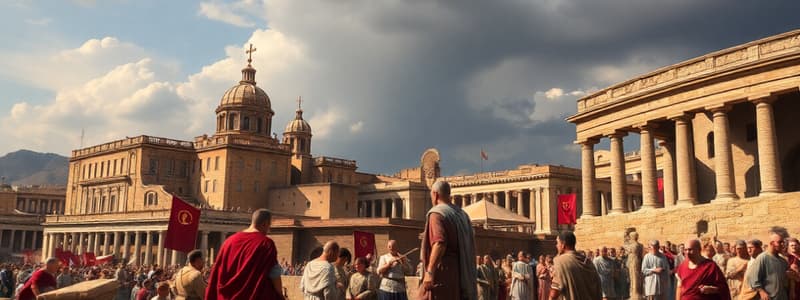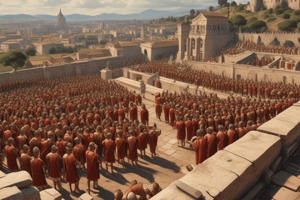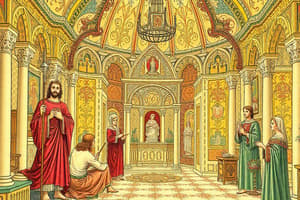Podcast
Questions and Answers
What key edict, signed by Emperor Theodosius, formalized Christian orthodoxy within the Roman Empire, and what council's creed did it establish as the norm?
What key edict, signed by Emperor Theodosius, formalized Christian orthodoxy within the Roman Empire, and what council's creed did it establish as the norm?
The Edict of Thessalonica established the Nicene Creed of the Council of Nicaea (325 AD) as the norm for Christian orthodoxy.
Briefly explain how the traditional Roman value system was impacted by the rise and subsequent adoption of Christianity as the state religion.
Briefly explain how the traditional Roman value system was impacted by the rise and subsequent adoption of Christianity as the state religion.
The divine status of the emperor and the glory of the State were replaced by the worship of the new god.
Describe how the decline of the Roman Empire's economy and military affected its ability to maintain its infrastructure and defend its borders.
Describe how the decline of the Roman Empire's economy and military affected its ability to maintain its infrastructure and defend its borders.
The Roman Empire lacked funds for maintaining infrastructure and experienced difficulties in defending its borders due to numerous wars, military overspending, and dwindling resources and manpower.
How did the writings of St. Augustine, such as Confessions and The City of God, influence the development of Christian thought during the decline of the Roman Empire and beyond?
How did the writings of St. Augustine, such as Confessions and The City of God, influence the development of Christian thought during the decline of the Roman Empire and beyond?
Explain how the evolution of the church-state relationship during the time of St. Ambrose influenced medieval concepts of Christian leadership.
Explain how the evolution of the church-state relationship during the time of St. Ambrose influenced medieval concepts of Christian leadership.
Why was the translation of the Bible into Latin by St. Jerome a significant event in the history of Christianity and the Roman Empire?
Why was the translation of the Bible into Latin by St. Jerome a significant event in the history of Christianity and the Roman Empire?
Describe the social and religious climate that allowed Christianity to spread during the Roman era, even amidst resistance and persecution.
Describe the social and religious climate that allowed Christianity to spread during the Roman era, even amidst resistance and persecution.
What actions did Emperors Decius and Valerian take to counteract the spread of Christianity, and how were these actions received by the Christian population within the Roman Empire?
What actions did Emperors Decius and Valerian take to counteract the spread of Christianity, and how were these actions received by the Christian population within the Roman Empire?
What role did the Roman Catholic Church play in maintaining a sense of unity and continuity within the fragmented territories of the former Roman Empire?
What role did the Roman Catholic Church play in maintaining a sense of unity and continuity within the fragmented territories of the former Roman Empire?
Explain how the toleration declared in the Edict of Milan in 313 AD and the later establishment of Christianity as the state religion impacted the religious landscape of the Roman Empire.
Explain how the toleration declared in the Edict of Milan in 313 AD and the later establishment of Christianity as the state religion impacted the religious landscape of the Roman Empire.
How did the weakening of the Roman Empire’s ability to expand through conquest contribute to internal issues such as the decline in the number of slaves?
How did the weakening of the Roman Empire’s ability to expand through conquest contribute to internal issues such as the decline in the number of slaves?
In what ways did the gospels being written in Koine Greek—the common language of the Roman Empire—aid in the dissemination of Christian teachings?
In what ways did the gospels being written in Koine Greek—the common language of the Roman Empire—aid in the dissemination of Christian teachings?
Briefly describe how the actions of Emperor Constantine the Great in 313 AD influenced the spread and acceptance of Christianity within the Roman Empire.
Briefly describe how the actions of Emperor Constantine the Great in 313 AD influenced the spread and acceptance of Christianity within the Roman Empire.
How did the pre-existing religious landscape of the Roman Empire, with its tradition of worshiping multiple gods, influence the way some individuals initially adopted Christianity?
How did the pre-existing religious landscape of the Roman Empire, with its tradition of worshiping multiple gods, influence the way some individuals initially adopted Christianity?
Summarize the key factors that contributed to the overall decline of the Roman Empire, as highlighted in the text.
Summarize the key factors that contributed to the overall decline of the Roman Empire, as highlighted in the text.
Flashcards
Who was Theodosius the Great?
Who was Theodosius the Great?
The emperor who made Christianity the official religion of the Roman Empire in 381 AD.
What is Christianity?
What is Christianity?
A monotheistic religion that became the official religion of the Roman Empire, replacing the traditional polytheistic Roman religion.
Who was Constantine the Great?
Who was Constantine the Great?
Ended all persecution of Christians in 313 AD with the Edict of Milan, allowing religious tolerance in the Roman Empire.
What is the Nicene Creed?
What is the Nicene Creed?
Signup and view all the flashcards
Who was Odoacer?
Who was Odoacer?
Signup and view all the flashcards
What is De officiis ministrorum?
What is De officiis ministrorum?
Signup and view all the flashcards
Who was St. Ambrose?
Who was St. Ambrose?
Signup and view all the flashcards
What are Confessions and The City of God?
What are Confessions and The City of God?
Signup and view all the flashcards
Who was St. Jerome?
Who was St. Jerome?
Signup and view all the flashcards
Who are the Latin Fathers of the Church?
Who are the Latin Fathers of the Church?
Signup and view all the flashcards
What is Koine Greek?
What is Koine Greek?
Signup and view all the flashcards
What was the Decline of Rome?
What was the Decline of Rome?
Signup and view all the flashcards
Study Notes
- The Roman Empire's collapse in the 4th century AD led to the rise of Christianity, with the Roman Catholic Church maintaining unity.
- In 381 AD, Christianity became the Roman Empire's official religion.
- Emperor Theodosius the Great was instrumental in establishing Christianity, suppressing paganism and Arianism.
- The Edict of Thessalonica, signed by Theodosius, established the Nicene Creed (325 AD) as the standard for Christian orthodoxy.
- The Christian religion, monotheistic, differed from the polytheistic Roman religion influenced by the Greek pantheon.
- This change followed prior persecution of Christians by Roman emperors in the 1st century.
- The Roman Empire's decline ended in 476 when Rome fell to a Germanic tribe led by Odoacer, who deposed Emperor Romulus Augustulus.
- From the 3rd century, Romans faced attacks from barbarian tribes, culminating in the Hun invasion in the late 4th century.
- The Roman army's repeated losses, military overspending, and halted expansion led to economic decline and fewer slaves.
- Infrastructure crumbled due to lack of funds and the rich leaving cities to avoid taxes.
- Political instability, corruption, and frequent emperor assassinations plagued the empire.
- The spread of Christianity replaced traditional Roman values, diminishing the emperor's divine status and state glory.
- Roman emperor Constantine the Great ended Christian persecution and declared toleration in 313 AD with the Edict of Milan.
- Traditionalist emperors Decius (249-251) and Valerian (253-260) briefly campaigned to promote Roman values and customs like animal sacrifices.
- The great persecution of Christians commenced in 303 under Emperor Diocletian, resulting in the arrest and execution of Christian leaders.
- Christianity spread through word of mouth and displays of spiritual power.
- Paul the Apostle traveled to spread Jesus Christ's message.
- Edward Watts notes the faith primarily spread through family, friends, and neighbors.
- Christianity spread easily because people could adopt the new religion alongside existing beliefs without changing cultural and religious practices.
- Worshipping Christ did not require rituals or hardships.
- The gospels were written in common Hellenistic Greek (Koine Greek).
- During the Roman Empire's decline, the Latin Fathers of the Church emerged.
St. Ambrose (339-397)
- Promoted Roman Christianity against Arianism and paganism
- Theologian and statesman
- Notable works include "De officiis ministrorum" (377–391) and "Exameron" (386–390).
- Developed concepts of church-state relations, preaching, and musical hymnography.
- Was unexpectedly made Bishop of Milan in 374.
- Composed hymns, including "Veni redemptor gentium."
- Influenced Augustine of Hippo's conversion to Christianity.
- Conceptualized the Christian emperor as a dutiful son of the Church.
St. Augustine (354-430)
- A significant figure in early Christianity and a Latin Father of the Church.
- Bishop of Hippo (modern day Algeria) from 396.
- First Christian philosopher and greatest Christian thinker after St. Paul.
- Adapted Platonic thought to Christian teaching, creating an influential theological system.
- Works include "Confessions" (c. 400) and "The City of God" (c. 413–426).
- Shaped biblical analysis and laid foundation for medieval and modern Christian thought.
- Formally recognized as a doctor of the Church in Roman Catholicism.
St. Jerome (347-419)
-
Contemporary of St. Augustine and also a doctor of the Church.
-
Translated the Bible into Latin.
-
Regarded as the most learned of the Latin Fathers.
-
Lived as a hermit, became a priest, and served as secretary to Pope Damasus I.
-
Established a monastery at Bethlehem in 389.
-
Authored biblical, ascetical, monastic, and theological works.
-
The Roman Catholic Church played a significant role in medieval society after the fall of the Roman Empire.
-
Towns and cities were designed with the church at the center, symbolizing its importance.
Studying That Suits You
Use AI to generate personalized quizzes and flashcards to suit your learning preferences.




